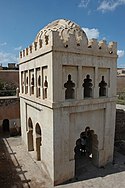Cimetière des musulmans à Damas
Engraver: Antoine Jean Weber (1797-1875)
Excerpts from the accompanying text, written by Pierre-Gustave Joly, published in Excursions daguerriennes (this text is in the public domain, like the image):
"[...] This plate shows only a small part of the Muslim cemetery of Damas. The mosque in the center is the tomb of a prince; the grilled cages surround and protect the graves of the rich; the numerous tumular stones mark the graves of the poor, and are often walked on by the passers-by. [...] In the background, the Anti-Lebanon Mountains can be seen [...] "
The original image is in the public domain.
Relevante Bilder
Relevante Artikel
QubbaQubba, auch Kubba, Kubbe, ist ein islamisches Grabmal, das von einer Kuppel überdacht wird. Qubba bezeichnet sowohl ein architektonisch herausragendes Mausoleum einer bedeutenden Persönlichkeit, als auch unabhängig vom gestalterischen Anspruch einen Grabbau oder eine Kultstätte an einem Ort, der mit dem Leben eines islamischen Heiligen oder verehrten Scheichs in Verbindung steht. Das in dem Bauwerk befindliche Grab oder Scheingrab (Kenotaph) ist im zweiten Fall ein Pilgerziel, von dem in der Vorstellung der Besucher Baraka (Segenskraft) ausgeht. Die Form des Kuppeldaches über der Grabstätte ist keine islamische Entwicklung und findet sich auch an Bauwerken der islamischen Architektur, die eine andere Funktion haben. Einige weltliche Repräsentationsbauten aus frühislamischer Zeit sind ebenfalls als Qubba bekannt. Der symbolische Gehalt einer überkuppelten Grabstätte geht auf bestimmte vorislamische Kultzelte zurück. .. weiterlesen














